|
What are the recent developments concerning arms control?
In the wake of the well financed and coordinated Al Queda terrorist activities, experts are
more than ever concerned about the consequences of widespread development of nuclear weaponry.
Yet global advancements in education and technology make it increasingly difficult to deter
countries or other entities which are intent on developing such armaments.
North Korea, which has withdrawn form the Nuclear NonProliferation Treaty, has recently
tested long range nuclear weapons, causing predictable international consternation. The US
continues to strive toward a diplomatic accommodation with the North Koreans. Iran's nuclear
program is causing considerable opposition from the US and Europe although it has apparent
widespread support among Iranians. The level of concern regarding Iran is greater than that
surrounding India, Pakistan, and Israel (nuclear countries who have not signed the Nuclear
NonProliferation Treaty) because Iran is in the Middle East and has some history of state
sponsored terrorism. The United States reputation of international leadership in the arms
control effort has been damaged by its own unilateral withdrawal from the Missile Defense
accord and by its recent declaration to assist India with its nuclear technology. In the
meantime, arms sales of conventional weaponry, particularly from the United States, continue
to accelerate.
What are the general issues concerning arms control?
Throughout history, the economic wealth of nations has been associated with military
superiority. This is generally true today  (Click to see chart), although some countries, notably Japan, have achieved significant economic
progress despite having minimal military power. During the past half century, technological
advancements in weaponry have challenged the wisdom of policies which support unlimited
military development. There is a broad international consensus, reflected in various
treaties, that there must be limits to military power. As a result, the U.S. intention to
develop an extensive missile defense system has caused considerable internal and international
controversy. Despite such opposition, the Bush Administration has indicated that it intends
to launch a massive spending program for the purpose of creating an effective system. (Click to see chart), although some countries, notably Japan, have achieved significant economic
progress despite having minimal military power. During the past half century, technological
advancements in weaponry have challenged the wisdom of policies which support unlimited
military development. There is a broad international consensus, reflected in various
treaties, that there must be limits to military power. As a result, the U.S. intention to
develop an extensive missile defense system has caused considerable internal and international
controversy. Despite such opposition, the Bush Administration has indicated that it intends
to launch a massive spending program for the purpose of creating an effective system.
What is the extent and danger of arms proliferation?
The concerns mainly involve the dangers associated with nuclear and chemical weapons
and the missiles designed to carry these payloads and other explosives. The danger may have
actually increased from the "cold war" years as more countries have developed the technical
capability to develop these weapons. Although most nuclear warheads are possessed by the five
acknowledged countries  (Click to see chart)
, India, Pakistan and Israel now have active nuclear arsenals and other countries are seeking
to develop such weapons. In October 2002, North Korea admitted that it had been operating a
nuclear weapons program despite a 1994 treaty agreement to abandon such a program thus expanding the number of countries possessing such weapons. (Click to see chart)
, India, Pakistan and Israel now have active nuclear arsenals and other countries are seeking
to develop such weapons. In October 2002, North Korea admitted that it had been operating a
nuclear weapons program despite a 1994 treaty agreement to abandon such a program thus expanding the number of countries possessing such weapons. 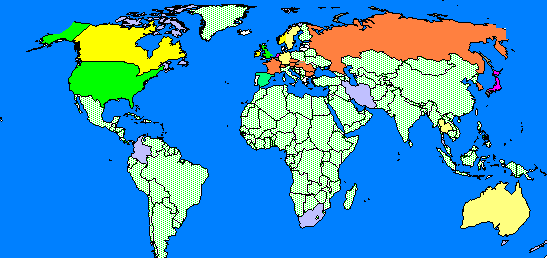 (Click to see map)
North Korea also formally withdrew from the Nuclear Non-Proliferation Treaty in 2003. The obvious dangers associated with this weaponry is that they
threaten civilian populations and the global environment. Moreover, despite the easing of
cold war tensions, the United States and Russia still maintain a readiness to launch massive
mutually destructive attacks and there remains a disturbing possibility of a mistaken
attack. (Click to see map)
North Korea also formally withdrew from the Nuclear Non-Proliferation Treaty in 2003. The obvious dangers associated with this weaponry is that they
threaten civilian populations and the global environment. Moreover, despite the easing of
cold war tensions, the United States and Russia still maintain a readiness to launch massive
mutually destructive attacks and there remains a disturbing possibility of a mistaken
attack.
What major agreements presently govern arms control?
- START I (1991) An agreement between the U.S., Russia and the former Soviet
republics to limit major nuclear weaponry. The agreement became effective in 1994 and must be
implemented by December 2001. The major limitations are:
- 1,600 deployed intercontinental ballistic missiles (ICBMs), submarine-launched ballistic
missiles (SLBMs), and heavy bombers for each side.
- 6,000 warheads of which no more than 4,900 may be on ICBMs and SLBMs
- START II (1993) An agreement between the U.S., Russia, and the former Soviet
republics to further limit nuclear weapons. Basically, the warhead limit was reduced to 3,500
of which no more than 1,750 could be on SLBMs. The U.S. Senate ratified this agreement in
January 1996 but Russia has made ratification contingent on U.S. acceptance of subsequently
negotiated agreements which extended the deadline and which made the Soviet republics parties
to the ABM treaty. Ratification was further delayed because of the U.S. intention to
withdraw from the ABM treaty. In May 2002, Russia and the U.S. negotiated a new treaty which,
like START II, reduces nuclear arsenals by about two thirds. This new treaty must now be
ratified by Congress and the Russian Dumas.
- ABM Treaty (1972) An agreement between the United States and the Soviet Union not
to develop extensive missile defense systems. The U.S. has maintained that testing and
development of ABM systems is within the scope of this agreement. In 2002, the Bush
Administration formally announced that the United States would be withdrawing from this
treaty.
- Chemical Weapons Convention (1993) A multinational agreement to eliminate
production and storage of chemical weapons. Only a very few countries have not signed and
ratified this agreement.
 There is an international inspection organization
to insure compliance. The U.S. has encountered some technological difficulties in destroying
some of its stockpile while Russia has faced economic obstacles in meeting destruction
deadlines. There is an international inspection organization
to insure compliance. The U.S. has encountered some technological difficulties in destroying
some of its stockpile while Russia has faced economic obstacles in meeting destruction
deadlines.
- Conventional Armed Forces in Europe Treaty (1990, modified in 1999) This treaty
places legally binding national ceilings on the conventional armed forces of every country
party to it and has special restrictions on forces in flank regions. It also contains
conflict resolution procedures for member states. The adapted treaty will not enter into
force until all 30 signing states ratify the agreement.
 President Clinton has
conditioned his submission of the agreement for Senate consideration on Russian compliance
with weapons limits set out in the document. President Clinton has
conditioned his submission of the agreement for Senate consideration on Russian compliance
with weapons limits set out in the document.
- Nuclear Non-Proliferation Treaty (1968) This treaty obligates the five nuclear
weapon states (Russia, United States, United Kingdom, France and China) not to transfer
nuclear weapons, other nuclear explosive devices, or their technology to any non-nuclear
weapon state. The non-nuclear weapon states agree not to acquire or produce nuclear weapons
or nuclear explosive devices. All nations are parties to this agreement except India,
Pakistan, Cuba, and Israel.
- Comprehensive Nuclear Test Ban Treaty (1996) This treaty was negotiated under the
auspices of the United Nations and prohibits any nuclear explosion whether for weapons or
peaceful purposes and includes a system for monitoring adherence to the ban. The treaty does
not become effective unless ratified by the five acknowledged nuclear weapon states and the
three threshold states of India, Pakistan and Israel. The United States Senate has not
ratified this treaty.
Why does the United States now want to develop a missile defense system?
The reason offered by most proponents of such a defense system is that conditions have
substantially changed since the original treaty. As more countries develop the capability of
manufacturing nuclear, chemical and missile weaponry, the security need to protect the U.S.
from attack has increased. But many other countries suspect that a truer motive is that a
successful system would render the U.S. as the only country capable of delivering and
repelling a nuclear attack, thus increasing its already dominant military and economic
position.
Opponents of a missile defense system argue that current efforts at developing such a
system have been ineffective and that any system developed would be very costly. Moreover,
they note that the abandonment of the ABM treaty jeopardizes the START II treaty and future
START III negotiations. They suggest that such a course would reverse the global direction
towards arms reduction and substitute a renewed arms race or other retaliatory measures by
Russia and China. European countries in particular have opposed the plan for the above
reasons and because it offers them no protection.
How do Democrats and Republicans stand on arms control?
Recent votes on arms control treaties reflect significant differences between the two
parties. Democrats have unanimously support all recent international efforts at arms control
whereas Republicans are responsible for the defeat of the test ban treaty.
 The 2008 Republican Party platform urges international cooperation in reducing nuclear
stockpiles but supports the concept of a capable missile defense system. The 2008 Democratic
platform advocates deep, verifiable reductions in United States and Russian nuclear weapons as
well as efforts with other nuclear powers to reduce global stockpiles dramatically. The
platform supports ratification of the Comprehensive Nuclear Test Ban Treaty, which will
strengthen the Nuclear Nonproliferation Treaty and aid international monitoring of nuclear
activities.
The 2008 Republican Party platform urges international cooperation in reducing nuclear
stockpiles but supports the concept of a capable missile defense system. The 2008 Democratic
platform advocates deep, verifiable reductions in United States and Russian nuclear weapons as
well as efforts with other nuclear powers to reduce global stockpiles dramatically. The
platform supports ratification of the Comprehensive Nuclear Test Ban Treaty, which will
strengthen the Nuclear Nonproliferation Treaty and aid international monitoring of nuclear
activities.
Arms Links
Open Directory-Disarmament
Wikipedia - Arms Control
Wikipedia - Treaty on Conventional Armed Forces in Europe
Wikipedia - Nuclear Non-Proliferation Treaty
Wikipedia - Nuclear proliferation
Wikipedia - START I
Wikipedia - START II
Wikipedia - Anti-Ballistic Missile Treaty
Wikipedia - Chemical warfare
Wikipedia - Chemical weapon
Wikipedia - Treaty on Conventional Armed Forces in Europe
Wikipedia - Comprehensive Nuclear-Test-Ban Treaty
|
Charts
(click to enlarge)
Ranking of Countries by GDP and Military Expenditures
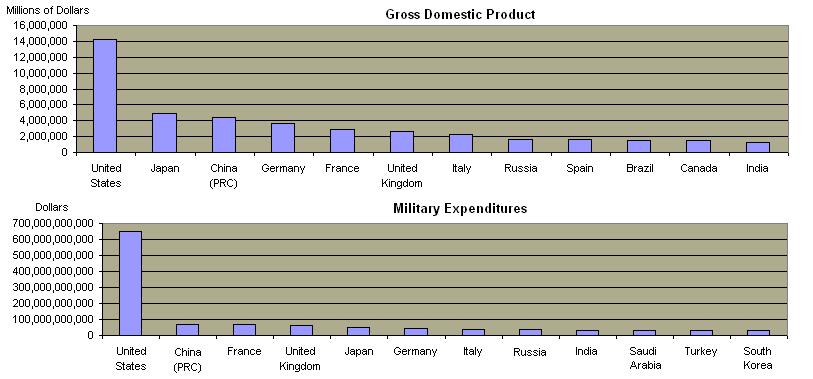
Distribution of Active Warheads Among NNPT Countries, 2011
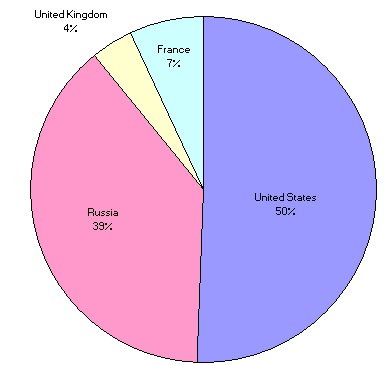
List of Countries With Nuclear Weapons

Parties to Convention on Chemical Weapons
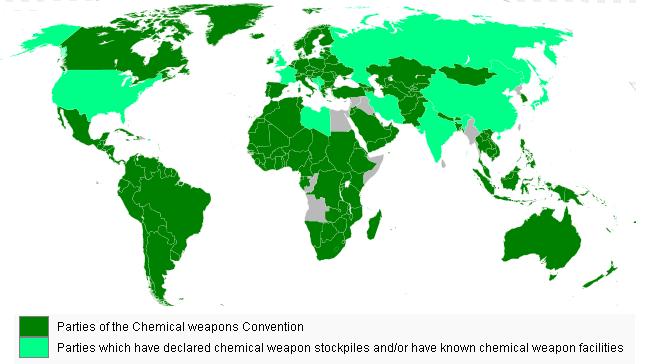
Signature Countries to Conventional Forces in Europe Treaty

Senate Votes on Arms Issues
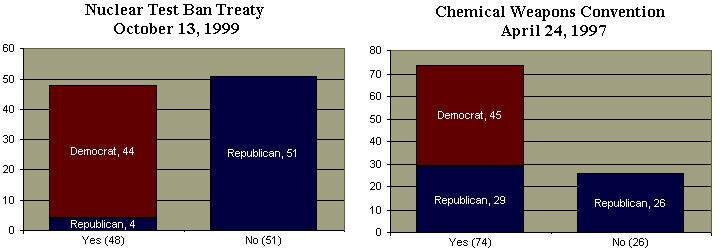
|

